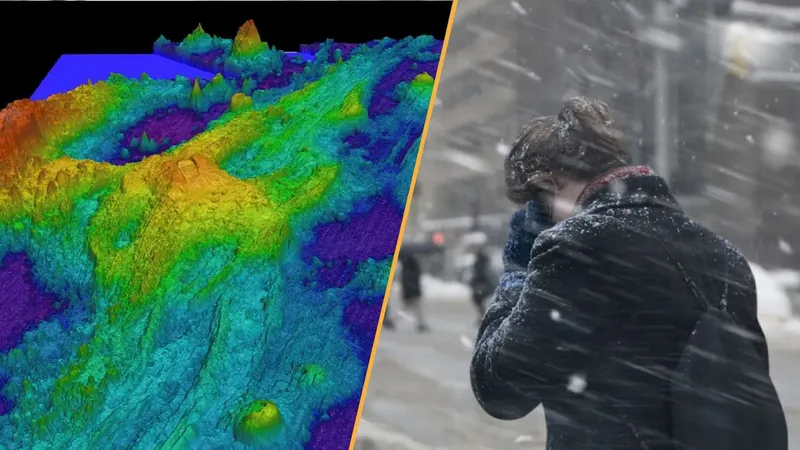
This Week in Science: Polar Vortex Impacts and Underwater Volcano Predictions
2025-01-04
Author: Li
In a chilly start to 2025, meteorologists are warning that an expanding polar vortex could lead to dangerously low temperatures sweeping across the eastern United States. Forecasters indicate that this January stands a strong chance of being the coldest in over a decade, bringing with it the potential for bitter weather conditions and Arctic-like air masses.
The Volcanoes of the Pacific: Axial Seamount Set to Erupt?
As temperatures drop on land, an undersea volcano off the Oregon coast is gaining attention for its potential to erupt in the coming year. Known as Axial Seamount, this underwater mountain lies approximately 300 miles (480 kilometers) west of Cannon Beach, Oregon. It is frequently active, providing scientists with a unique opportunity to observe and study volcanic behavior close to the continental shelf.
While predicting volcanic eruptions remains a challenging task—typically only possible days in advance—geologists are hopeful that continued research at Axial will yield valuable insights. By examining the correlation between surface activity and the subterranean movement of magma and fluids, researchers aim to enhance their long-term eruption forecasting capabilities. This knowledge could ultimately prove vital in safeguarding coastal communities.
A Discovery from the Past: Alexander the Great’s Battleground
In a groundbreaking archaeological find, researchers have unveiled the historic site of the Battle of Granicus, fought in 334 B.C. The battle marked a significant moment in Alexander the Great's campaign against the Persian Empire. Although the location had been shrouded in mystery for centuries, recent archaeological efforts in northwest Turkey have led to the discovery of human remains and weaponry, lending credence to the hypothesis regarding the battlefield’s geography.
With the application of modern technologies, including geo-referencing and 3D reconstructions, archaeologists have been able to visualize what the landscape looked like during Alexander's time, helping to verify the battle site and dismiss alternative theories.
Additional Science Highlights This Week
1. Avian Health Alert: In Los Angeles County, pet cats are now being diagnosed with bird flu linked to the consumption of certain raw foods and dairy products.
2. Surgical Anomaly: A surgical procedure turned bizarre when a surgeon inadvertently transplanted a tumor into his own hand, raising questions about surgical protocols and their enforcement.
3. Jurassic Discoveries: Bumpy features found in a UK quarry have been confirmed as ancient dinosaur pathways, traversed by some of the largest dinosaurs of the Jurassic era.
4. Emerging Viral Concerns: A rise in human metapneumovirus (HMPV) infections among children in China has drawn the attention of health officials, highlighting the need for greater awareness and potential preventative measures.
Innovations in Robotics
The realm of robotics continues to push boundaries with astonishing innovations. From microscopic devices designed for targeted drug delivery to lively humanoid companions, the sector is flourishing. A recent compilation highlights eight of the most extraordinary robots currently making waves, showcasing engineering marvels and fascinating concepts.
Stargazing Events Not to Miss
For astronomy enthusiasts, this week is full of celestial spectacles. The Quadrantid meteor shower is set to grace the night sky, offering a stunning display of "shooting stars." Additionally, skywatchers in Europe can look forward to witnessing Saturn as it briefly disappears behind the moon.
Captivating Glimpses of Earth from Space
Lastly, a breathtaking photograph taken from the International Space Station captures the ethereal beauty of Earth's landscapes. In this stunning image, Kol'tsevoye Lake in Russia is nestled between two volcanoes, its surface transformed into a shimmering expanse of clouds, an illusion created by the atmospheric phenomenon known as "sunglint."
Stay informed and intrigued as science continues to unveil the wonders of our planet and beyond!
 Brasil (PT)
Brasil (PT)
 Canada (EN)
Canada (EN)
 Chile (ES)
Chile (ES)
 Česko (CS)
Česko (CS)
 대한민국 (KO)
대한민국 (KO)
 España (ES)
España (ES)
 France (FR)
France (FR)
 Hong Kong (EN)
Hong Kong (EN)
 Italia (IT)
Italia (IT)
 日本 (JA)
日本 (JA)
 Magyarország (HU)
Magyarország (HU)
 Norge (NO)
Norge (NO)
 Polska (PL)
Polska (PL)
 Schweiz (DE)
Schweiz (DE)
 Singapore (EN)
Singapore (EN)
 Sverige (SV)
Sverige (SV)
 Suomi (FI)
Suomi (FI)
 Türkiye (TR)
Türkiye (TR)
 الإمارات العربية المتحدة (AR)
الإمارات العربية المتحدة (AR)